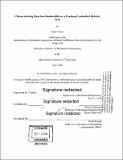Characterizing reaction bandwidths in a position-controlled robotic arm
Author(s)
Gano, Selam
DownloadFull printable version (1.739Mb)
Other Contributors
Massachusetts Institute of Technology. Department of Mechanical Engineering.
Advisor
Alberto Rodriguez.
Terms of use
Metadata
Show full item recordAbstract
Position-controlled robotic manipulators remain an industry standard but are ill-suited for guarded move approaches to advanced manipulation. Adding additional feedback with the expectation that a position-controlled system can account for it cannot guarantee successful implementation. To explore and define the limitations of position-controlled arms, I attempt to characterize different motion and force bandwidths of a large, 6-DOF robotic arm. Peak force and motion overshoot measurements were taken at varying speeds of the robot. These experiments showed that at speeds as low as 10 mm/s, the robot still exerted over 40 Newtons of force, enough to crush objects typically used for manipulation tasks. Overcoming these issues in using position-controlled arms are difficult to account for with software approaches, but different mechanical solutions can be envisioned to combat this problem in robotic manipulation.
Description
Thesis: S.B., Massachusetts Institute of Technology, Department of Mechanical Engineering, 2018. Cataloged from PDF version of thesis. Includes bibliographical references (page 11).
Date issued
2018Department
Massachusetts Institute of Technology. Department of Mechanical EngineeringPublisher
Massachusetts Institute of Technology
Keywords
Mechanical Engineering.